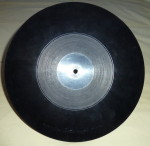Little
Wonder Records |
|
| I worked with Tim Brooks to create a completely revised and updated history and discography of Little Wonder records and Bubble Books (see cover at left).- The book was published by Mainspring Press.- This book, released in 2011, expands the first history and discography published in 1999 and results from the combination of my Little Wonder research and record collection and Tim Brooks' knowledge of Columbia. Since no company files survive, major Little Wonder collectors have pooled their information to create this discography.- In cases where collectors have no knowledge about a particular record number, though, it's impossible to tell whether that number was never used or has simply not been discovered yet.- For example, I've found a double-sided test pressing of two records (#96 and #97, see left) that do not seem to have been released, but there is no way to know for sure.- For about half of the records, the contributors have also been able to identify -- or at least make educated guesses about -- the artists that made the recording.- This is the most exhaustive listing created to date. Unfortunately, Mainspring Press has changed its business to digital only and this discography is no longer in print. -It's likely to still be available through some dealers and I have a few copies left that I could sell. -If you would like to purchase the book from me, just contact me. Little Wonder Release Dates Using information from Sears, Roebuck and Co. catalogs, other contemporary published sources, and the composition dates for the tunes, release dates for the Little Wonder record series have been estimated.- The first Little Wonders were released in September 1914, and the last seem to date from the spring of 1923. A short series of numbers from 1784 through 1795 was used to re-record children's tunes for the Columbia electrically recorded version of the Bubble Books (see Bubble Book discography).
Little Wonder records were sometimes issued in multiple "takes" (different recordings of the same tune by the same artists, often recorded in the same recording session).- The take number appears in one of two places, depending on whether the record was issued earlier or later in the history of Little Wonders.- On the early records, there is a hand-etched record number in the "runoff" or "wax" (the shiny area between the label and the grooves).- Sometimes there is also a machine-stamped record number in that area, but the one to find on the earlier records looks hand-etched.- Most of the time, that hand-etched number is followed by a dash, and that dash is followed by a number (for example, 308-1 or 308-2).- The number after the dash is the take number (1 and 2, respectively, in the example). On the later records, there is a mechanically stamped number in the runoff and none that look hand-etched.- Above that mechanically stamped number is a raised series of letters and numbers, in the format "number-letter-number" (for example, 2-A-26), and the first number is the take number.- You sometimes have to look very closely because the series is often in the label area and difficult to see, and the series is not printed, only raised.- One tip to make finding it easier is that the take numbers are lined up exactly above the first number of the record number (for example, the hypothetical series 2-A-26 would start just above the number "1" on record number 1298). |






